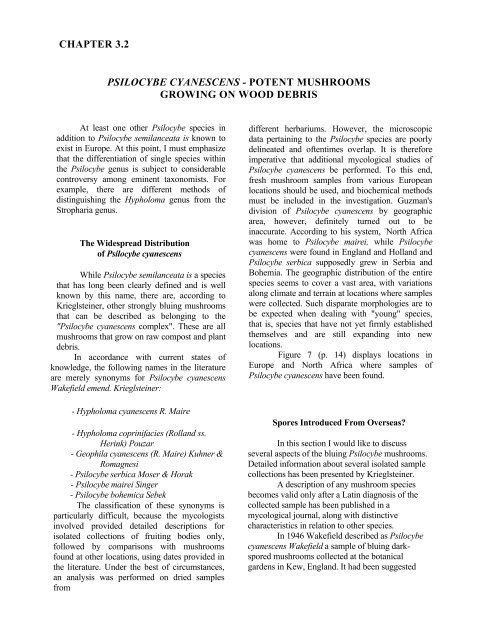Jochen Gartz - Magic Mushrooms Around the ... - preterhuman.net
Jochen Gartz - Magic Mushrooms Around the ... - preterhuman.net
Jochen Gartz - Magic Mushrooms Around the ... - preterhuman.net
You also want an ePaper? Increase the reach of your titles
YUMPU automatically turns print PDFs into web optimized ePapers that Google loves.
CHAPTER 3.2<br />
PSILOCYBE CYANESCENS - POTENT MUSHROOMS<br />
GROWING ON WOOD DEBRIS<br />
At least one o<strong>the</strong>r Psilocybe species in<br />
addition to Psilocybe semilanceata is known to<br />
exist in Europe. At this point, I must emphasize<br />
that <strong>the</strong> differentiation of single species within<br />
<strong>the</strong> Psilocybe genus is subject to considerable<br />
controversy among eminent taxonomists. For<br />
example, <strong>the</strong>re are different methods of<br />
distinguishing <strong>the</strong> Hypholoma genus from <strong>the</strong><br />
Stropharia genus.<br />
The Widespread Distribution<br />
of Psilocybe cyanescens<br />
While Psilocybe semilanceata is a species<br />
that has long been clearly defined and is well<br />
known by this name, <strong>the</strong>re are, according to<br />
Krieglsteiner, o<strong>the</strong>r strongly bluing mushrooms<br />
that can be described as belonging to <strong>the</strong><br />
"Psilocybe cyanescens complex". These are all<br />
mushrooms that grow on raw compost and plant<br />
debris.<br />
In accordance with current states of<br />
knowledge, <strong>the</strong> following names in <strong>the</strong> literature<br />
are merely synonyms for Psilocybe cyanescens<br />
Wakefield emend. Krieglsteiner:<br />
- Hypholoma cyanescens R. Maire<br />
- Hypholoma coprinifacies (Rolland ss.<br />
Herink) Pouzar<br />
- Geophila cyanescens (R. Maire) Kuhner &<br />
Romagnesi<br />
- Psilocybe serbica Moser & Horak<br />
- Psilocybe mairei Singer<br />
- Psilocybe bohemica Sebek<br />
The classification of <strong>the</strong>se synonyms is<br />
particularly difficult, because <strong>the</strong> mycologists<br />
involved provided detailed descriptions for<br />
isolated collections of fruiting bodies only,<br />
followed by comparisons with mushrooms<br />
found at o<strong>the</strong>r locations, using dates provided in<br />
<strong>the</strong> literature. Under <strong>the</strong> best of circumstances,<br />
an analysis was performed on dried samples<br />
from<br />
different herbariums. However, <strong>the</strong> microscopic<br />
data pertaining to <strong>the</strong> Psilocybe species are poorly<br />
delineated and oftentimes overlap. It is <strong>the</strong>refore<br />
imperative that additional mycological studies of<br />
Psilocybe cyanescens be performed. To this end,<br />
fresh mushroom samples from various European<br />
locations should be used, and biochemical methods<br />
must be included in <strong>the</strong> investigation. Guzman's<br />
division of Psilocybe cyanescens by geographic<br />
area, however, definitely turned out to be<br />
inaccurate. According to his system, - North Africa<br />
was home to Psilocybe mairei, while Psilocybe<br />
cyanescens were found in England and Holland and<br />
Psilocybe serbica supposedly grew in Serbia and<br />
Bohemia. The geographic distribution of <strong>the</strong> entire<br />
species seems to cover a vast area, with variations<br />
along climate and terrain at locations where samples<br />
were collected. Such disparate morphologies are to<br />
be expected when dealing with "young" species,<br />
that is, species that have not yet firmly established<br />
<strong>the</strong>mselves and are still expanding into new<br />
locations.<br />
Figure 7 (p. 14) displays locations in<br />
Europe and North Africa where samples of<br />
Psilocybe cyanescens have been found.<br />
Spores Introduced From Overseas<br />
In this section I would like to discuss<br />
several aspects of <strong>the</strong> bluing Psilocybe mushrooms.<br />
Detailed information about several isolated sample<br />
collections has been presented by Krieglsteiner.<br />
A description of any mushroom species<br />
becomes valid only after a Latin diagnosis of <strong>the</strong><br />
collected sample has been published in a<br />
mycological journal, along with distinctive<br />
characteristics in relation to o<strong>the</strong>r species.<br />
In 1946 Wakefield described as Psilocybe<br />
cyanescens Wakefield a sample of bluing darkspored<br />
mushrooms collected at <strong>the</strong> botanical<br />
gardens in Kew, England. It had been suggested








![The Big Lie 9-11 and Government Complicity in Mass Murder [PDF]](https://img.yumpu.com/50957077/1/190x245/the-big-lie-9-11-and-government-complicity-in-mass-murder-pdf.jpg?quality=85)








